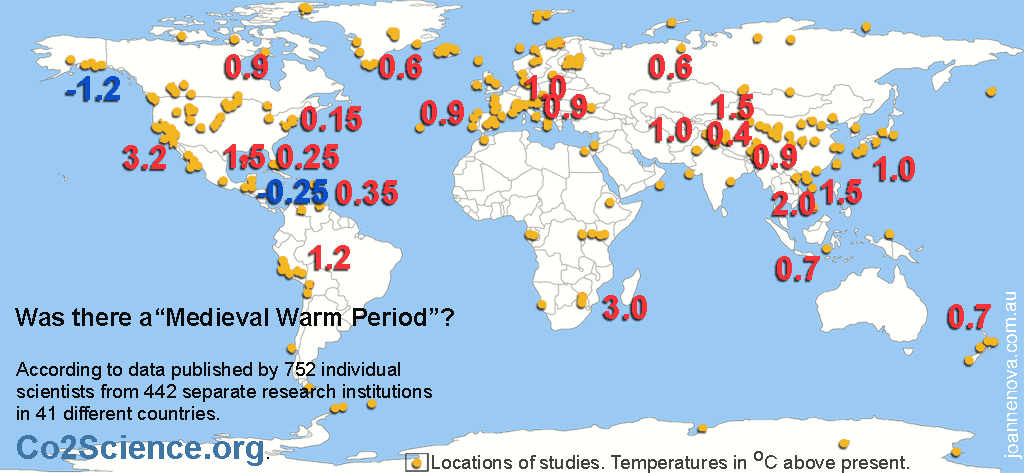![]()
by Joanna Nova:
Here we go again. For five or so years believers didn’t really mention the Medieval Warm Period. Too bruised by the embarrassment of Hockey Stick Zombie failures. But it’s an inconvenient era they have to rub out because none of the expert models can explain what caused it, and it’s hard to panic about same temperatures that Edward the Confessor survived with oxen and carts.
And it’s hard to call the modern warmth “man-made” if nature created something just like it 1,000 years ago.
Climate change: We haven’t experienced anything like this in the past 2,000 years
By Michael Collett, ABC, Environmental Copy and Paste Promoter
Climate scientists writing in the journal Nature have found there is no evidence for “globally coherent warm and cold periods” over the past 2,000 years prior to industrialisation.
That’s significant, because climate change deniers have sometimes pointed to epochs like the so-called “Little Ice Age” or “Medieval Warm Period” to argue that the current global warming is one among multiple similar global climate events.
But what the research actually shows is that other “peak warming and cooling events” over the past two millennia appear to have been localised, whereas the human-caused global warming observed over the past 150 years is unparalleled in its global scale (not to mention its absolute temperatures).
Who’s denying a million raw data points?
This new global temperature reconstruction by The Pages Consortium miraculously agrees with the models yet disagrees with hundreds of stalagmites, corals, ice cores, trees, lake sediments, mud from the ocean floor, pollen dust and 6,000 boreholes. It disagrees with the history of people’s like the Vikings. It disagrees with plants that grew and with trees that survived “above the snowline” that’s shouldn’t. This map shows just some temperature estimates from all around the world during medieval times relative to today.
Many of these papers come from Craig Idso at CO2Science.org maintains the Medieval Warm Period Project. Back in 2009 when I did this map for the Skeptics Handbook II it was a first. Even then, there were already 442 separate research institutes from 41 countries which had published papers showing the MWP.* Also thanks to Luning and Vahrenholt, and the team at NoTricksZone.The latest paper is trying to claim that all these temperatures were not recorded at the same time and that it wasn’t global. But when proxies are combined it’s obvious it was. Even in our modern warm period, there are still warm and cold records being set at the same time. Medieval times were no different. It’s only by collating and combining many proxies that we can see “the average”.



It seems the left won’t believe anything unless it is wrong.
Liberals are Gullible enough to beleive everything they see on CNN or read in the NYT’s
@Spurwing Plover: Some of that is not just gullibility. They also like the hate the liberal media spews out. It reinforces their own prejudices, bigotry and racism.
Global warming projections based on rising CO2 levels already take natural variations in climate such as the “Medieval Warm Period” and the more recent “Little Ice Age” into account. Are you unaware of this?
@Greg: None of the left’s climate predictions ever come to pass. It’s a fraud.
The fraud is in the White House.
EPA to allow use of pesticide considered ‘very highly toxic’ to bees
@Greg: MOST pesticides are toxic to bees.